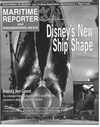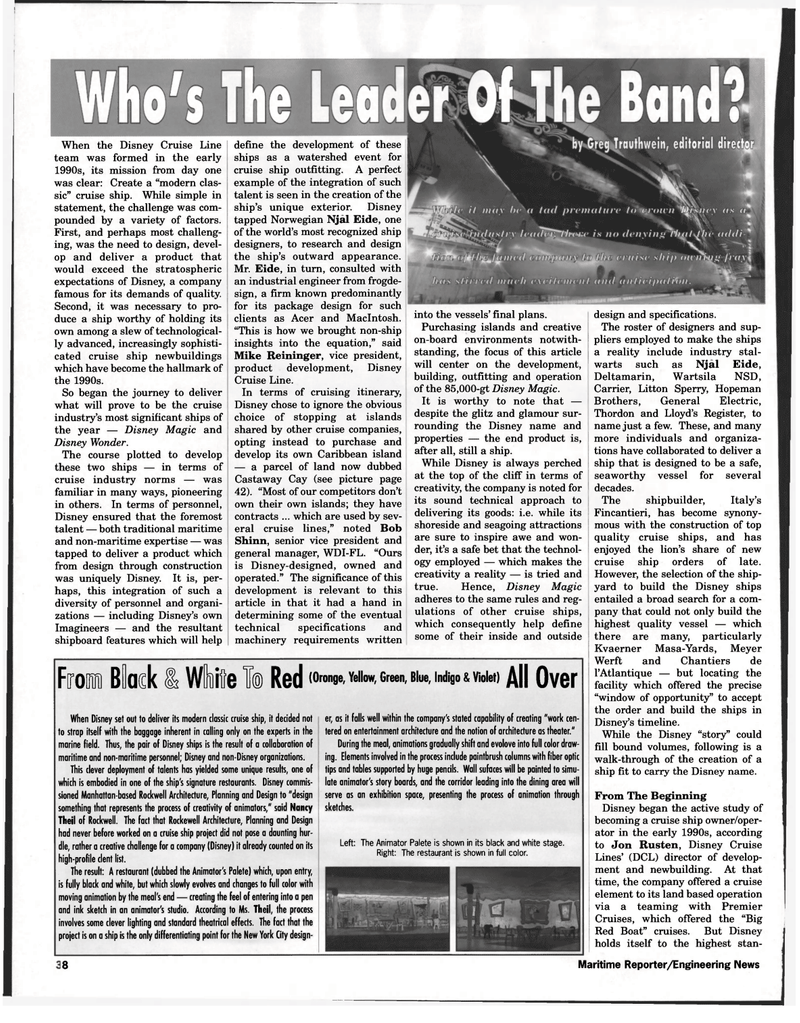
Page 40: of Maritime Reporter Magazine (March 1998)
Read this page in Pdf, Flash or Html5 edition of March 1998 Maritime Reporter Magazine
When the Disney Cruise Line team was formed in the early 1990s, its mission from day one was clear: Create a "modern clas- sic" cruise ship. While simple in statement, the challenge was com- pounded by a variety of factors.
First, and perhaps most challeng- ing, was the need to design, devel- op and deliver a product that would exceed the stratospheric expectations of Disney, a company famous for its demands of quality.
Second, it was necessary to pro- duce a ship worthy of holding its own among a slew of technological- ly advanced, increasingly sophisti- cated cruise ship newbuildings which have become the hallmark of the 1990s.
So began the journey to deliver what will prove to be the cruise industry's most significant ships of the year — Disney Magic and
Disney Wonder.
The course plotted to develop these two ships — in terms of cruise industry norms — was familiar in many ways, pioneering in others. In terms of personnel,
Disney ensured that the foremost talent — both traditional maritime and non-maritime expertise — was tapped to deliver a product which from design through construction was uniquely Disney. It is, per- haps, this integration of such a diversity of personnel and organi- zations — including Disney's own
Imagineers — and the resultant shipboard features which will help define the development of these ships as a watershed event for cruise ship outfitting. A perfect example of the integration of such talent is seen in the creation of the ship's unique exterior. Disney tapped Norwegian Njal Eide, one of the world's most recognized ship designers, to research and design the ship's outward appearance.
Mr. Eide, in turn, consulted with an industrial engineer from frogde- sign, a firm known predominantly for its package design for such clients as Acer and Macintosh. "This is how we brought non-ship insights into the equation," said
Mike Reininger, vice president, product development, Disney
Cruise Line.
In terms of cruising itinerary,
Disney chose to ignore the obvious choice of stopping at islands shared by other cruise companies, opting instead to purchase and develop its own Caribbean island — a parcel of land now dubbed
Castaway Cay (see picture page 42). "Most of our competitors don't own their own islands; they have contracts ... which are used by sev- eral cruise lines," noted Bob
Shinn, senior vice president and general manager, WDI-FL. "Ours is Disney-designed, owned and operated." The significance of this development is relevant to this article in that it had a hand in determining some of the eventual technical specifications and machinery requirements written into the vessels' final plans.
Purchasing islands and creative on-board environments notwith- standing, the focus of this article will center on the development, building, outfitting and operation of the 85,000-gt Disney Magic.
It is worthy to note that — despite the glitz and glamour sur- rounding the Disney name and properties — the end product is, after all, still a ship.
While Disney is always perched at the top of the cliff in terms of creativity, the company is noted for its sound technical approach to delivering its goods: i.e. while its shoreside and seagoing attractions are sure to inspire awe and won- der, it's a safe bet that the technol- ogy employed — which makes the creativity a reality — is tried and true. Hence, Disney Magic adheres to the same rules and reg- ulations of other cruise ships, which consequently help define some of their inside and outside
Frail Black i Wlife T© Red (Oror^e, Yellow, Green, Blue, Indigo & «ole.) All Ovei"
When Disney set out to deliver its modern classic cruise ship, it decided not to strap itself with the baggage inherent in calling only on the experts in the marine field. Thus, the pair of Disney ships is the result of a collaboration of maritime and non-maritime personnel; Disney and non-Disney organizations.
This clever deployment of talents has yielded some unique results, one of which is embodied in one of the ship's signature restaurants. Disney commis- sioned Manhattan-based Rockwell Architecture, Planning and Design to "design something that represents the process of creativity of animators," said Nancy
Theil of Rockwell. The fact that Rockewell Architecture, Planning and Design had never before worked on a cruise ship project did not pose a daunting hur- dle, rather a creative challenge for a company (Disney) it already counted on its high-profile dent list.
The result: A restaurant (dubbed the Animator's Palete) which, upon entry, is fully black and white, but which slowly evolves and changes to full color with moving animation by the meal's end — creating the feel of entering into a pen and ink sketch in an animator's studio. According to Ms. Theil, the process involves some clever lighting and standard theatrical effects. The fact that the project is on a ship is the only differentiating point for the New York City design- er, as it falls well within the company's stated capability of creating "work cen- tered on entertainment architecture and the notion of architecture as theater."
During the meal, animations gradually shift and evolove into full color draw- ing. Elements involved in the process include paintbrush columns with fiber optic tips and tables supported by huge pencils. Wall sufaces will be painted to simu- late animator's story boards, and the corridor leading into the dining area will serve as an exhibition space, presenting the process of animation through sketches.
Left: The Animator Palete is shown in its black and white stage.
Right: The restaurant is shown in full color. design and specifications.
The roster of designers and sup- pliers employed to make the ships a reality include industry stal- warts such as Njal Eide,
Deltamarin, Wartsila NSD,
Carrier, Litton Sperry, Hopeman
Brothers, General Electric,
Thordon and Lloyd's Register, to name just a few. These, and many more individuals and organiza- tions have collaborated to deliver a ship that is designed to be a safe, seaworthy vessel for several decades.
The shipbuilder, Italy's
Fincantieri, has become synony- mous with the construction of top quality cruise ships, and has enjoyed the lion's share of new cruise ship orders of late.
However, the selection of the ship- yard to build the Disney ships entailed a broad search for a com- pany that could not only build the highest quality vessel — which there are many, particularly
Kvaerner Masa-Yards, Meyer
Werft and Chantiers de l'Atlantique — but locating the facility which offered the precise "window of opportunity" to accept the order and build the ships in
Disney's timeline.
While the Disney "story" could fill bound volumes, following is a walk-through of the creation of a ship fit to carry the Disney name.
From The Beginning
Disney began the active study of becoming a cruise ship owner/oper- ator in the early 1990s, according to Jon Rusten, Disney Cruise
Lines' (DCL) director of develop- ment and newbuilding. At that time, the company offered a cruise element to its land based operation via a teaming with Premier
Cruises, which offered the "Big
Red Boat" cruises. But Disney holds itself to the highest stan- 78B Maritime Reporter/Engineering News

 39
39

 41
41
